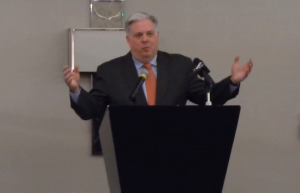Tip of the ‘Burg’: Investigating the Causes and Future Implications of the Budget Crisis
The spring semester at Frostburg State University started with a sad fizz more than a bang this year, due to the extensive budget cuts facing the University and State of Maryland. Extensive coverage of the budget cuts for the current academic year have been featured in past editions of The Bottom Line, but the lasting and semi-permanent effects of the cuts have yet to be identified.
The Bottom Line has reached out to administrators, personnel, and coordinators across campus to make sense of the current budget crisis and to help inform the student body and campus community of the potential ripple effects of these cuts, including administrative action to decrease spending within the various sectors of a public, secondary academic institution like FSU.
Making sense of the legislative, political, and educational aspects of the budget cut is convoluted and often disorienting, which is somewhat typical of public financing in general. Due to the rapid-fire nature of gubernatorial actions and consequent reactions, it is helpful to take a chronological approach to the crisis.
Causes
The genesis of the budget cuts comes from a deficit in the State of Maryland, created by a lack of revenue to support spending. Many are quick to blame former Governor Martin O’Malley for the deficit, arguing that the Democratic governor created the deficit during his two terms in Annapolis. While it is true that the state general fund was operating at a deficit for 62.5% of O’Malley’s eight years in office, he is hardly the first to do so. O’Malley’s predecessor, Republican Robert Ehrlich, operated the same general fund at a deficit for 50% of his four years in office. Since the year 2000, the general fund has operated through Republican and Democratic administrations and suffered a deficit for nine years, with only six years featuring a surplus, landing the state and university system in their current situations.
In November of 2014, the University System of Maryland (USM) was notified that there would be a budget cut of $8.5 million to the system, resulting in a $300,000 cut to FSU. O’Malley, potentially in a last-ditch effort to quell conservative critics of spending and alleviate his successor of such a large state deficit, announced further budget cuts for the 2015 fiscal year before Governor Hogan came to office. FSU President Jonathan Gibralter, in comments presented to the FSU Faculty Senate on February 4, stated that these cuts were made in conjunction with the Board of Public Works only eight days prior to O’Malley’s departure from the Governor’s mansion and totaled “over 400 million dollars.” This cut included a $40 million cut to the university system and trickled down to Frostburg State with a $1.25 million cut. Days before the spring semester began, the FSU cuts, previously quoted at $300,000, skyrocketed nearly five times to $1.25 million.
With the university in intercession and 61% of the FSU budget already automatically allocated to personnel salaries, the FSU administration was forced to raise student tuition at the last minute, announcing a student tuition increase of 2%, or $58. This tuition increase was applied to the Spring 2015 semester. Other emergency cuts included: $400,000 of facilities renewal funds, delaying construction projects on campus; $25,000 of marketing funds, consisting of advertising allocations; $25,000 worth of travel reduction; $80,000 worth of “enrollment management, partially depleting the Noel-Levitz contract;” and $380,000 of a savings account of sorts, titled the “Use of Fund Balance.” These cuts were made in response to the O’Malley budget cuts through the Board of Public Works and were effective before Governor Hogan came into office.
O’Malley was succeeded by Larry Hogan, a Republican businessman who previously served as the Secretary of Appointments for Maryland Governor Bob Ehrlich. On January 23, the newly-elected governor spoke at PACE, a Western Maryland gathering of elected officials, residents, and area leaders of education and industry. At the event, Governor Hogan’s keynote address stressed the importance of balancing the budget in the future to avoid deficits like those stemming from the past two administrations. Hogan announced that his own submitted budget is “structurally balanced for the first time in 10 years.” He elaborated and claimed that his budget “puts Maryland on sound financial footing without raising taxes or fees, without eliminating any services or agencies, and without laying off a single employee or introducing any furloughs.” Hogan went on to assert “historic high spending on K-12 education” while pledging to raise higher education spending. The Hogan budget contained a supposed 1.3% increase in spending for the university system.

gathering. (Courtesy Amanda Mangan, Allegany Radio Corporation News)
In between governors, an apparent utter lack of communication between the outgoing O’Malley administration and incoming Hogan administration exasperated the already chaotic budget situation. FSU Provost Dr. Bill Childs believes that there was “little, if any, consulting between the O’Malley and Hogan administrations.” Concerning the 1.3% increase to USM funding in the Hogan budget, Dr. Childs states that it was “unclear” if the increase was made before the O’Malley cut or after.
Dr. Gibralter asserts that “careful review” of the Hogan budget revealed that, indeed, “several mistakes were made,” including the failure of the Hogan budget to account for the O’Malley cuts. This miscommunication, in addition to Governor Hogan’s desire to balance the budget “without raising taxes or fees,” has resulted in the transformation of a supposed 1.3% increase in the USM budget to the reality of an additional $47 million cut to the USM through what Dr. Childs refers to as the “back of the budget reductions.”
This planning catastrophe has yet to be resolved for the future. Dr. Childs states that the university will not know exactly what funding it will receive for fiscal year 2016 until April of this year, when the state will (presumably) approve a budget.
Next Steps
While the state cuts funding on paper, Frostburg State University must make very real changes to comply financially in the future. Dr. Childs stated that the cuts this semester were “quick fixes” and harsher measures will have to be taken during the next academic year. The emergency cuts in 2015 are actually a very small change on campus compared to what must be done to remain financially soluble.
FSU faculty and staff are receiving arguably harsher blows than the students. In January of 2015, state employees, including faculty and staff at FSU, were given a 2% Cost of Living Allowance (COLA) raise. Due to the aforementioned chaos, all state employees will lose this COLA raise on July 1 of this year. To put this in perspective, the average faculty member at Frostburg State will effectively have a salary reduction of $1,357.66. Additionally, faculty and staff will not be receiving merit raises for exemplary work.
Students should know that the impending further tuition increase is only a very small way in which they will be affected by these cuts. The effects of the cuts on faculty and staff could potentially trickle down to students. Merit raises ensure that excellent work is rewarded, and productivity may suffer in the absence of encouragement. Furthermore, no new initiatives will occur concerning facilities renewal, delaying much-needed residence renovations.
In an effort to save money through adjunct and overload contracts for extra course sections, the Provost, in coordination with the Registrar, will attempt to eliminate a total of 50 sections for the fall 2015 semester and an additional 50 during the spring 2016 semester. At $2,000 a course, this would result in savings of $200,000 for the 2015-2016 year. This change could potentially result in larger class sizes for students, particularly in introductory-level courses. Dr. Childs stressed his desire to do this in an efficient manner in hopes of minimizing the effect on students. The Registrar is reportedly currently working with departments across campus to plan for the decreased sections. With 25 departments across campus, this reform would equate to a sacrifice of two sections per department.
A more work-intensive method of savings could occur through evaluation of under-performing programs. Increasing efficiency saves marginal amounts of money, and reforming programs and majors on campus can result in small savings. To determine which majors are “underperforming,” administrators look at the number of degrees awarded in the past three years, in cooperation with the Office of Planning, Assessment, and Institutional Research. If a program has failed to award at least 15 degrees, it is considered underperforming. For example, one such program is the Department of Philosophy. In the past three years, the philosophy department has only awarded nine degrees: two in 2012, five in 2013, and two in 2014. Other examples of underperformance are programs which are sub-categories or divisions of programs on campus, like Interpretive Biology & Natural History (Biology Department) and Urban & Regional Planning (Geography Department).
To bolster efficiency and, thus, save money, several approaches may be taken. First, departments may choose to reform the program, potentially making the program easier to complete, hopefully increasing enrollment within a two year timeframe. The obvious downside of this is that it requires time – something the University may have precious little of around the budget deadline in April. Streamlining the majors may be an option, as would consolidating concentrations, like the biology and geography examples above. Consolidating similar majors doesn’t save money on the surface but streamlined processes could save operational money over time. By consolidating two departments, two department chairs become one, saving money by eliminating the extra salary for one chair.
A more draconian approach may be eliminating the programs altogether. Through this approach, the university would save money by eliminating the faculty and staff positions within that department. For example, if the Philosophy department was, indeed, deemed underperforming and incapable of reform, about $257,414 would be saved annually from faculty salaries alone. This doesn’t account for staff or adjunct contracts.
Program and personnel terminations are obviously severe cuts that would only be implemented under the most dire of circumstances. As Dr. Childs states, the personnel “are the heart of this institution.” However, the logistics of eliminating full-time positions are lucrative on paper. By cutting adjunct and overload contracts, the university saves money per section it cuts. By cutting the equivalent of a full-time position in adjunct contracts, the University saves $16,000. By eliminating full-time positions, the university would save entire salaries in one fell swoop, with salaries in underperforming departments typically ranging from $35,000 to $60,000. In addition, savings would come from eliminating benefits, which include medical, dental, life, disability, counseling, vision, and flexible spending for daycare and medical. These benefits are standard for state employees and costly.
An equally undesirable fix may come in the form of furloughs, officially dubbed “salary reduction days.” Furloughs are very efficient in generating mass amounts of money in relatively short amounts of time. The last university furloughs occurred in 2011 and implemented “progressive” furloughs, in a system much like progressive tax rates. Personnel on campus who made higher, six-figure salaries had as many as ten furlough days in 2011, while smaller staff positions may have had none. By implementing a campus-wide furlough for one day, about half a percent of savings is created. The University of Maryland at College Park has already implemented furlough days this Spring in addition to tuition raises and a one-time surcharge.
The severity and nature of these approaches largely depends on the issue of enrollment and retention. At the February 4 Faculty Senate meeting, Dr. Childs and David Rose, the Vice-President for Administration and Finance, stated that the fall 2015 “enrollment data will be huge.” With a goal of enrolling 1,000 first-time freshman (an increase of 39 from 2014-2015), the university hopes to generate more revenue from first-time freshman, who typically live on campus and pay for room and board. Associate Vice-President for Admissions and Financial Aid Wray Blair reports that admissions is “currently running ahead of last year on offers of admission and paid admission deposits for freshman applicants.” On an optimistic note, Blair states that he believes that enrolling 1,000 first-time freshman is “an attainable goal.”
Transfer students are also becoming increasingly important, as the economic recession following 2008 led to more students beginning at community colleges and later transferring to 4-year schools like FSU. Transfer students, however, typically do not live on campus or pay room and board. Wray Blair again brings hopeful tidings concerning transfer students, stating that “we [FSU] have been enrolling record transfer classes the last few years and are currently trending toward another increase in transfer enrollment for fall 2015.” Blair attributes this trend to FSU’s reputation as “a strong option for transfer students throughout Maryland and the region.” The enrollment results will play a very large role in determining what gets cut in 2015-2016. In the words of the Provost, “you can’t operate with these [budget and enrollment] numbers and be successful.”
Regional Ripples
The current and future budget cuts and subsequent campus reform will affect students and personnel first. However, it is important to note that the ripple effects of this budget crisis, specifically at FSU, will most likely spread to the campus community. A 2012 study performed by the FSU College of Business (COB) analyzes the economic impact of FSU on the surrounding region, namely Allegany County. Stimulating the local economy is a cornerstone of the FSU mission, with Strategic Goal 6 of the University being to “serve as a catalyst for economic development in Western Maryland, the region, and the state.” With tuition increases occurring, students may be less inclined to spend money at off-campus locations in the county. The COB study asserts that “total annual expenditures reported by FSU students are estimated to be $55,712,087, of which 80 percent, or $44,682,729, are estimated to occur within Allegany County itself.” FSU students are invaluable sources of business to many establishments in Allegany County, and additional financial burdens like increased tuition may hamper off-campus spending.
Additionally, the report states that FSU is “the second largest employer in Allegany County,” accounting for 2.7 percent of the total civilian labor force in the county. Furthermore, 79% of FSU personnel live in Allegany County. Interestingly, the report asserts that the gross average annual income of FSU employees is about $56,947. When compared to the county median annual household income of $39,408, it is apparent that the University plays a major role in county employment. With COLA reductions, a lack of merit raises, and potential furloughs and terminations, the University directly affects a large portion of residences and businesses in the county. While Allegany County continues to hold the title of the poorest county in Maryland, and while the area struggles to attract new business or industry, these budget numbers are unwelcome news to anyone who calls Western Maryland home – student or otherwise.
It is clear that the current and future budget cuts are, indeed, a crisis, that could affect a very large amount of students, faculty, staff, and area residents. Indeed, Dr. Childs describes the process as “a whole bunch of moving parts,” which make it difficult to see the entire machine. At the end of the day, the Provost reminds us that “what we have to adhere to is providing top quality instruction to students.” In a gesture of collaboration, Dr. Childs urges anyone “with novel ideas” to “let someone know.” College students are notoriously frugal, and budget solutions very well may come from the student body. Going forward, it is imperative to remember that the administration must comply with these budget cuts, as they are mandated by the state. Tough cuts are coming, likely in many of the aforementioned methods. Cooperation and understanding will be important to effectively weather the fiscal storm.
For the latest news on the budget situation, visit us online at www.thebottomlinenews.com.


